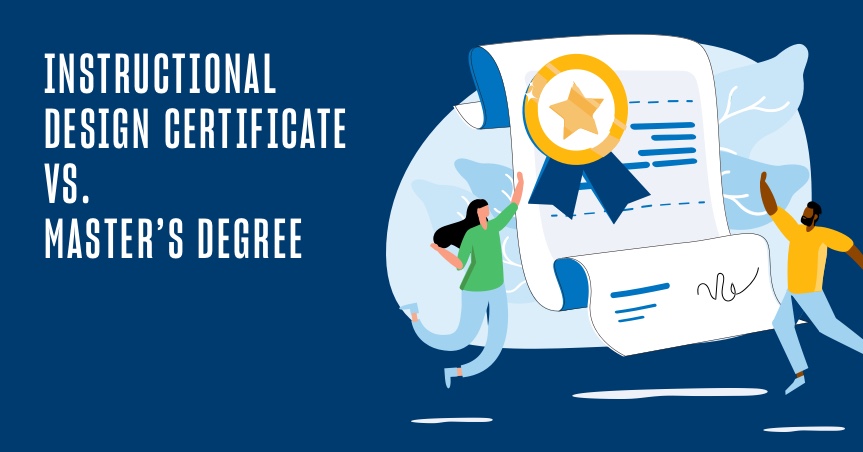As a learning designer, you’ll work with various technology tools that facilitate communication, collaboration and creativity. And whether you’re teaching a virtual class or presenting in-person training, digital tools will play a role in how you plan, instruct, provide feedback and so much more.
There are a lot of instructional technology tools out there, so how can you navigate them all and figure out where to start? Consider this post a helpful guide as we look at popular learning technologies that aid the learning process.
What Is Instructional Technology?
Instructional technology is both the theory and practice of developing, managing and then evaluating the combination of tools, hardware, software and resources to facilitate learning in a variety of environments.
Instructional designers specifically:
- Design and develop technology-driven instructional solutions to foster learning.
- Make use of software, apps, and web-based tools to facilitate the delivery of that instruction.
- Research and integrate new ideas, approaches and technologies to enhance the learning process.
While the term “instructional technology” is sometimes used as shorthand for the actual tools used by those that work in education, for our purposes we specify those as instructional technology tools. These tools enhance teaching and learning in K-12 and college or university environments, and enhance learning solutions in corporate, government, and nonprofit settings.
Instructional Technology vs. Educational Technology
Though instructional technology (IT) and educational technology (ET) sound like they should be the same thing, there are important differences:
- Scope – IT is focused more on specific how-to instruction, whereas ET is a wider scope of theoretical approaches, philosophical applications on how tech can support education.
- Goals – IT is about enhancing teaching and learning process through technology, ET is focused on expanding technological literacy to achieve learning goals.
- Use – IT is mainly concerned with which tools should be used for instruction, while ET is more about how those tools should be used for learning.
In general, think of Educational Technology as a larger, top down approach that seeks to achieve long-term goals, while Instructional Technology has more specific applications for instruction.
What Are the Benefits of Instructional Technology?
So, what makes it worth using IT tools? According to theU.S. Department of Education’s Office of Educational Technology, instructional technology resources:
- Increase education productivity by accelerating the rate of learning
- Increase accessibility for students
- Improve the process of assessment
- Enable more coordination and collaboration
Specifically, effective use of the technologies allows for:
- More opportunities to improve student engagement through different techniques like gamification and virtual interaction.
- Greater opportunity for personalized instruction, since students have more tools to learn at their own pace, to draw upon additional resources or receive assistance when needed.
- New ways to collaborate through online interaction, thanks to real-time technology like video chat or asynchronous communication through messaging boards and email.
- Better means of gathering feedback and encouraging direct responses through applications like live polls, quizzes and automatically generated word clouds.
- More support for instructors to create their own lessons, design curriculum and develop resources. The digital maker space allows instructors to customize an open environment where students are encouraged to engage, communicate and interact.
[RELATED RESOURCE] Discover how instructional design prepares you to meet today’s workplace challenges.
Top 10 Instructional Technology Tools
Whether you’re teaching children or adults, are in education or corporate training, be sure to take some time to familiarize yourself with these 10 leading instructional tech tools:
- Adobe Captivate – An authoring tool that allows users to create eLearning content through the use of out-of-the-box assets and templates. Users can design their own screencasts, virtual tours, quizzes, branching courses and more.
- Aha Slides – This web-based application allows you to create presentation slides with interactive elements like polls, quizzes and Q&A sessions. Students follow links or scan a QR code to reply or answer, and the results are tallied and displayed in real time.
- AnswerGarden – A free to use online word cloud application where you can ask a question and the results are automatically generated based on responses. You can use it as a standalone application or embed it into a website or presentation.
- Articulate Storyline 360 – One of the most popular tools for creating eLearning courses, Storyline 360 is part of the Articulate 360 platform. Featuring a large library of assets, including templates, videos, icons and more, it allows for the creation of interactive training that works across both desktop, tablets, and mobile devices.
- Crowdsignal – A tool designed to quickly create polls and surveys that you can integrate within multiple applications or share via email. You can export results to spreadsheet applications such as Google Sheets and Excel.
- Google Applications – Google provides a host of different applications with different features and functions to facilitate learning and instruction. Docs, Slides, Workspace and Classroom are high-profile examples of Google tools used in instructional technology.
- H5P – Short for HTML 5 Package, H5P is a free, open-source platform for creating collaborative web-based content. Developers can create mobile friendly interactive videos, presentations and games that easily integrate with Learning Management Systems (LMS) like Blackboard, Canvas or Moodle.
- PollEverywhere – An online engagement tool that makes use of surveys, quizzes, word clouds and live polling. You can use these polling features as a stand-alone tool or within different virtual meeting platforms. Its customizable content structure can be made to fit different workflows.
- Slack – A business communication platform from Salesforce that allows for distance learning collaboration through channels, virtual presentations, instant updates and announcements. As a platform, Slack is able to integrate with applications from Google, Microsoft and other third-party developers.
- Sli.do – Designed to allow interaction within hybrid meetings, this application features live polls, quizzes and word clouds that can be used across a host of different applications, including PowerPoint, YouTube and Google Slides.
[PDF GUIDE] Still curious about the tools used in instructional design? See how they support online learning.
Instructional Technology Resources
A tool is only as effective as the hand that wields it, so if you’re looking for more understanding in how to best integrate these tools into courses, then consider reviewing any of these helpful sites:
- LessonCast
- TeacherTube
- SchoolTube
- Smithsonian Science Education Center
- U.S. Office of Educational Technology
- U.S. Department of Education
If you want a full understanding of the theories and practices that can help you utilize these tools to their fullest potential, then you should consider looking into a graduate degree program in instructional or learning design.
Here at the University of San Diego’s master’s degree program in Learning Design and Technology, we’re committed to helping educators master the art and science of using technology to help people learn. We have several courses designed to teach best practices for utilizing learning technologies and we provide our students with guidance in several areas – such as how to use course authoring software and how to create interactive learning experiences.
Contact us if you’d like to know more about USD’s LDT program and curriculum.

![Top 10 Instructional Technology Tools [+How They Benefit You]](https://onlinedegrees.sandiego.edu/wp-content/uploads/2022/12/ldt_blog_top10idtools-1.png)


![Top 15 Tools Used by Instructional Designers [+ How to Choose]](https://onlinedegrees.sandiego.edu/wp-content/uploads/2022/11/ldt_blog_15tools-1024x576.png)
![Top 10 Instructional Design Careers [+ Salary Guide]](https://onlinedegrees.sandiego.edu/wp-content/uploads/2022/03/ldt_blog_top10idcareers-1024x576.png)